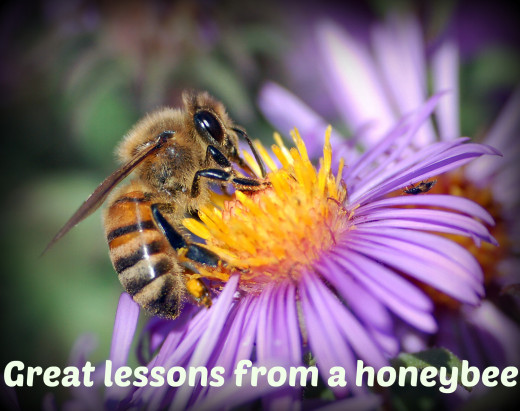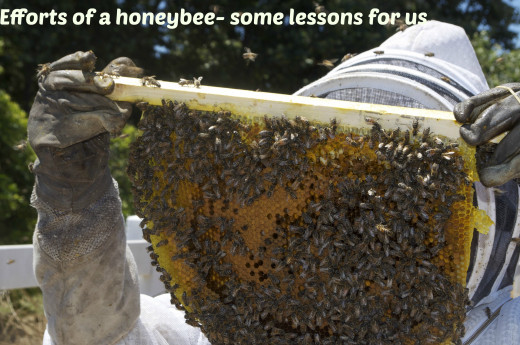Efforts Put in by the Honeybee

Every morning, I go for a walk to the nearby park. For the last few days, I have been noticing honeybees wandering in the park, looking for nectar and pollens from the flowers. I was fascinated by their efforts to make honey. This made me write about the efforts the honeybees put in to make honey.
Honeybee is considered to be a social insect as they always live in colonies. In one hive, about 40,000 to 60,000 bees live together. If we observe their colony structure, they have a unique division of labor there. There are three main groups of bees in a hive.
The queen
The queen is the only sexually capable female in the hive. By size, she is the largest bee in the hive. The selection to turn a larva into a queen is made by worker bees. They select a two-day larva and feed it well on nectar and pollens, to be turned into a queen. This queen later mates with male bees, called drones, to produce eggs. Several million sperms are transferred to queen during this mating. These are enough to be utilized throughout her life span, which is usually two years. She starts laying eggs about 10 days after mating. In a single day, she can lay up to 3,000 eggs.
The drones
These are the male bees in the hive without any stingers. Their only function is to mate with the queen. They have no other job to do. During the time when there is shortage of food, they are kicked out of the hive to die in severe weather.
The workers
These are the smallest bees in a hive and are sexually undeveloped. In a hive, their number varies from 40,000 to 60,000. All the work to collect the pollen and nectar is performed by this group. Their life span varies based on which time of the year they were born in. Normal life span is 28-35 days. Their duties include collecting pollen as well nectar, to guard the hive, to feed the queen and larva and to control the temperature of the hive by fanning with their wings. The buzzing sound is produced due to this fanning, even when they are not flying or during nighttime.
The hive consists of hexagonal cells to store honey and pollens. The worker bees have great responsibility to collect pollens as well as nectar from the flowers. They are never tired of their work and do it without any break, throughout their life until they die. To make about one pound of honey, they have to travel to about two million flowers and about 55,000 miles. During one trip, a worker usually visits 50-100 flowers to collect nectar. This is a huge task but they are always doing that. On an average, one worker bee produces about less than half of teaspoon of honey during the whole of her life. They depict a great teamwork, resulting in a lot of honey that we have to enjoy. A dedicated teamwork is required to convert the nectar into honey. This whole task is performed by worker bees. When they come back to the hive with the nectar from flowers, the other workers receive the nectar mouth to mouth and transfer them to specific hexagonal cells for storage. After the nectar is stored, they fan with their wings to moderate the temperature of the hive. Gradually about 70% of the moisture in the nectar evaporates and the remaining solution turns to honey. The pollens collected by other workers are also stored in the hive, later mixed with the nectar to make food for everyone in the hive, particularly the larvae. The honey is actually their stored food for the time when the weather is not favorable and no flowers bloom. This includes the autumn and winter season.
Did you expect honeybee could be of this much benefit for us?
The honey produced by the honeybee is unique in its taste and composition. Man has not been able to produce honey artificially. He always has to depend on these little machines of nature for honey. The honey can stay fresh for extended periods of time without any threat of being infected by virus and bacteria. Honeybee is a great and unique flying machine created by nature for the benefit of man. She can always carry a weight almost equal to her own. This is quite different from even the modern aircrafts these days. The highly developed aircrafts can only carry about one quarter of their own weight.
Lesson for us
In the life of honeybee, there is a lot to learn for us. Like her, we should never loose heart but should always continue doing our duties well. Honeybees give us a great lesson of charity. There is always some share for others in what we earn. As I mentioned in my other article (why should we help others), helping others always gives us an inner feeling of happiness and pleasure that cannot be had by other means. We should always be thankful to God for all the blessings that he has bestowed upon us. The whole nature is there for us, to ponder upon and thank God.










